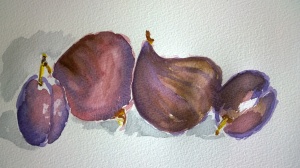Quick watercolour studies (cont.)
I enjoyed doing these exercises. The small size means you do not have to spend a great deal of time on each one, although I did spend quite some time on the drawings which are in the sketchbook. I find those help me look at tone, line and texture without having to think about colour.
Painting without following a line of a pencil was new for me and I enjoyed the freedom it gives.
We were asked to keep the colours clear, that is, not mixing too many colours together and in the last exercise with the plums it is apparent why. In the first one, at the top, I used the colours quite pure, but as I tried to make them darker I mixed them and in the third one at the bottom it shows as the colours are quite ‘muddy’ and a lot less vibrant.
The line drawings were fun to do, it was like drawing with a brush rather than painting, and I am glad I kept the studies of line and tone separate as in the one with the grapes I tried them together and did not feel it was as successful. I find it easier to concentrate on one thing at a time.
All the quick watercolour studies were done on 22″x30″ watercolour NOT 140lb

Same as below, continuing with studies on how to express tone, line and texture in watercolours. I wanted to try some really dark colours, again very similar. Alizarin Crimson with Ultramarine, Purple Lake with Burnt Umber and Cad Orange with Emerald. I found that I needed to combine more or less all of them to get the colours I wanted.



This time I remembered to add some shadows, it makes a big difference I think. The mix is Viridian and Alizarin Crimson.

































You must be logged in to post a comment.